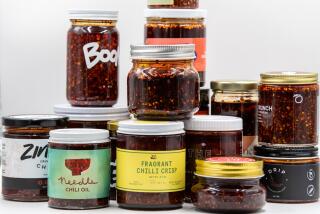Discussions Are Usually Heated When It Comes to Chili Peppers
Ever notice how pretty the coloring is on a diamondback rattlesnake just before it bites you? No? Then you’d better have a seat. This is going to be dangerous reading. We’re going to talk about growing chilies.
(Note to those few readers who are now jumping up and down and clapping their hands: Meet me in Rosarito Beach next weekend for the semi-regular stomach-lining-destruction party and all-night burp-a-thon.)
We’ll get to the eating part later. Let’s just ease into things right now by recognizing that chilies, in all their benign and lethal varieties, can be lovely plants to look at and a true visual asset to your garden.
For instance, check out the description of one variety in a recent seed catalogue: “These striking multibranching plants with their brilliant-colored, spicy fruits grow to three feet tall and never need staking. Plants are soon covered with vivid purple blossoms followed by big bursts of pointed, one-inch-long, glossy little purple chilies that slowly mature into brilliant red. . . . (The) continuous abundance of shiny deep purple fruits make them extra ornamental. Their fruit-laden branches are a visually hot feast for the eye as well as the palate.”
Having said that, you ought to know that this variety is new and is known as the “Firecracker” chili. It’s a variety of the pequin chili, which is described by Jane Butel in her book “Chili Madness” (1980, Workman Publishing) as “the most devilishly hot of all. . . . It’s really only recommended for those who have absolutely fireproof palates or a satanic addiction.”
But, as is common among chili aficionados, there is disagreement. Shepherd’s Garden Seeds, the company in Felton, Calif., that offers the “Firecracker,” also lists the “Habanero” variety in its catalogue, and asserts that it is “the hottest chili we know. . . . The bright orange fruits are said to be anywhere from 100 to 300 times hotter than jalapenos.”
And that, friends, borders on the nuclear.
But even this little bundle of sure-death makes a nice ornamental addition to the garden, with its high color, tam-o’-shanter shape (they’re also known as “Scotch bonnets”) and large, vigorous leaves.
It’s like that with most varieties of chilies, and there are probably thousands throughout the world, said Dave DeWitt, the editor of Albuquerque-based Chile Pepper magazine, a bimonthly publication for the truly chili-crazed. The varieties, he said, range in size and type from “the very short and bush-like to the tree-like, and the pods can be erect or pendant. There’s a lot to look at in a pepper garden.”
DeWitt should know. He grows dozens of varieties in his garden and is the author of a forthcoming book called “Pepper Gardening” (Ten Speed Press). One seed bank in Iowa, he said, has about 500 chili pepper varieties in stock “and seed companies are adding new varieties all the time.”
This mania has been stoked by what DeWitt called changing immigration patterns in the United States. With the arrival of more and more immigrants from such volcano-food regions as Southeast Asia, the Caribbean, Mexico and Central and South America, “it’s opened our eyes to more types of hot and spicy foods.”
But not only food. With chili peppers, “the actual distinction between edible plants and ornamental plants gets blurred,” said DeWitt. Not only can you harvest and eat the peppers fresh, or dry them and grind them into powder, you can watch them turn, as they ripen, from green to yellow to red (peppers harvested when red are sweeter).
Growing these botanical hand grenades is easy, but--believe it or not--these aggressive plants have to be babied a bit in the early stages, said Beth Benjamin, a horticultural consultant for Shepherd’s Garden Seeds.
“They like the heat and they particularly like areas with warmer nights,” she said. “And they tend to get even hotter and more flavorful in hotter areas of the country.”
The seeds should be planted indoors in fine potting soil and watered regularly. Bottom heat is the best encouragement, said Benjamin, and can be had by placing the plants on top of a refrigerator or inside an oven with a pilot burning.
After eight to 10 weeks, the plants can be moved outside, where they should be mulched and then watered once or twice a week.
As ornamentals, they do particularly well in pots, said Benjamin, as well as in combination in a bed with sunflowers. And if you plant them indoors today, you’ll be ready to harvest them--and the yield is often large--by mid-September, she said.
Not all chilies, of course, will drive you gasping to your knees. But, Benjamin said, there may be a third reason to grown them, apart from their beauty and their bite. She told of one customer who took particular pride in having a healthy growth of the lava-like “Habanero” in his yard.
To him, said Benjamin, “it was kind of like having a pet pit bull or something.”
Attack chilies. It could work.






